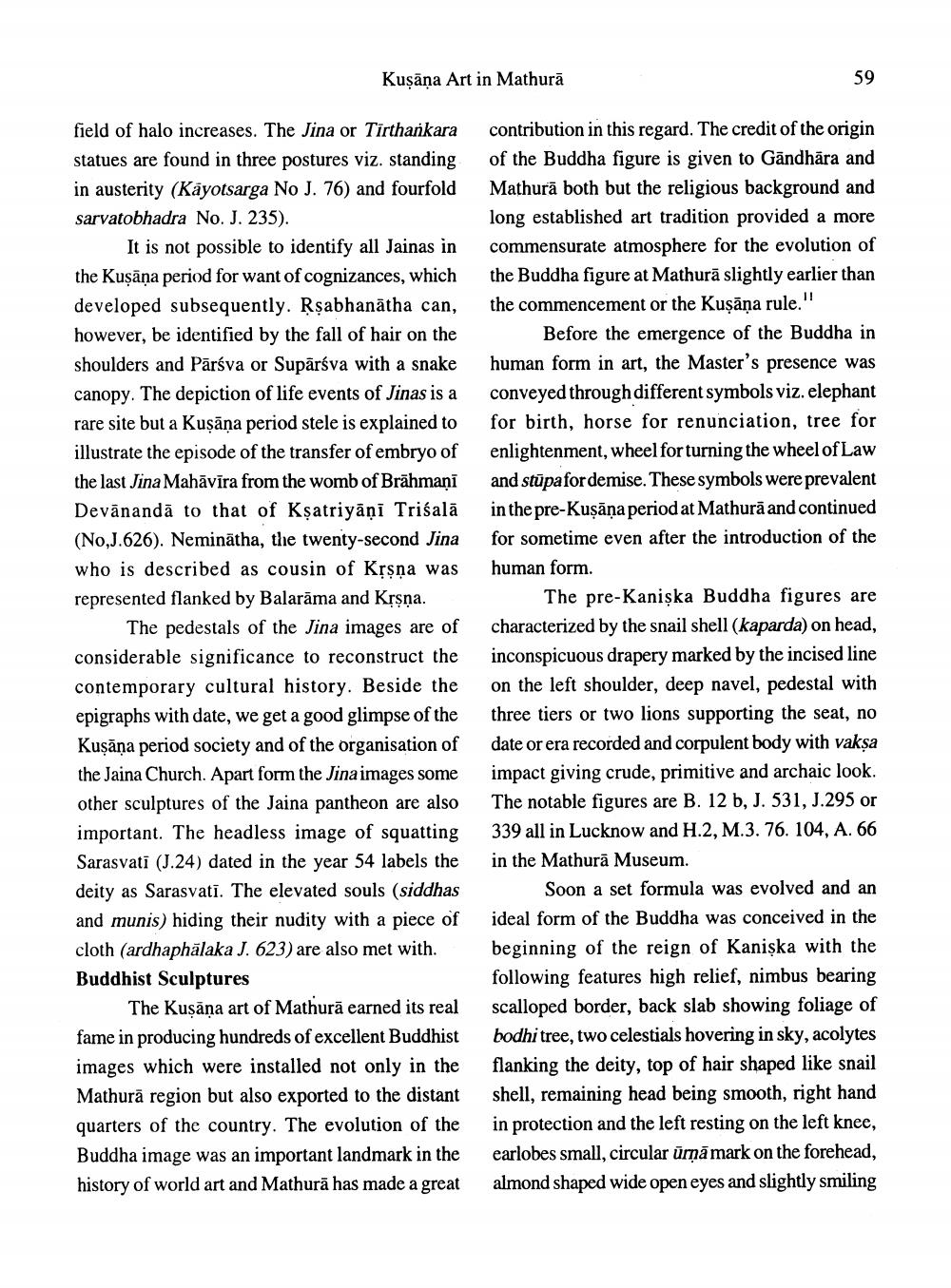________________
Kuşāna Art in Mathurā
59
field of halo increases. The Jina or Tirthankara statues are found in three postures viz. standing in austerity (Käyotsarga No J. 76) and fourfold sarvatobhadra No. J. 235).
It is not possible to identify all Jainas in the Kuşāņa period for want of cognizances, which developed subsequently. Rşabhanātha can, however, be identified by the fall of hair on the shoulders and Pārsva or Supārśva with a snake canopy. The depiction of life events of Jinas is a rare site but a Kuşāņa period stele is explained to illustrate the episode of the transfer of embryo of the last Jina Mahāvīra from the womb of Brāhmaṇi Devānandā to that of Ksatriyāņi Trišalā (No,J.626). Neminātha, the twenty-second Jina who is described as cousin of Krsna was represented flanked by Balarāma and Krşņa.
The pedestals of the Jina images are of considerable significance to reconstruct the contemporary cultural history. Beside the epigraphs with date, we get a good glimpse of the Kusīņa period society and of the organisation of the Jaina Church. Apart form the Jina images some other sculptures of the Jaina pantheon are also important. The headless image of squatting Sarasvati (J.24) dated in the year 54 labels the deity as Sarasvati. The elevated souls (siddhas and munis) hiding their nudity with a piece of cloth (ardhaphālaka J. 623) are also met with. Buddhist Sculptures
The Kuşāņa art of Mathurā earned its real fame in producing hundreds of excellent Buddhist images which were installed not only in the Mathurā region but also exported to the distant quarters of the country. The evolution of the Buddha image was an important landmark in the history of world art and Mathurā has made a great
contribution in this regard. The credit of the origin of the Buddha figure is given to Gāndhāra and Mathurā both but the religious background and long established art tradition provided a more commensurate atmosphere for the evolution of the Buddha figure at Mathurā slightly earlier than the commencement or the Kuşāņa rule."
Before the emergence of the Buddha in human form in art, the Master's presence was conveyed through different symbols viz. elephant for birth, horse for renunciation, tree for enlightenment, wheel for turning the wheel of Law and stūpafor demise. These symbols were prevalent in the pre-Kuşāņa period at Mathurā and continued for sometime even after the introduction of the human form.
The pre-Kaniska Buddha figures are characterized by the snail shell (kaparda) on head, inconspicuous drapery marked by the incised line on the left shoulder, deep navel, pedestal with three tiers or two lions supporting the seat, no date or era recorded and corpulent body with vaksa impact giving crude, primitive and archaic look. The notable figures are B. 12 b, J. 531, J.295 or 339 all in Lucknow and H.2, M.3. 76. 104, A. 66 in the Mathurā Museum.
Soon a set formula was evolved and an ideal form of the Buddha was conceived in the beginning of the reign of Kaniska with the following features high relief, nimbus bearing scalloped border, back slab showing foliage of bodhi tree, two celestials hovering in sky, acolytes flanking the deity, top of hair shaped like snail shell, remaining head being smooth, right hand in protection and the left resting on the left knee, earlobes small, circular ārņāmark on the forehead, almond shaped wide open eyes and slightly smiling




